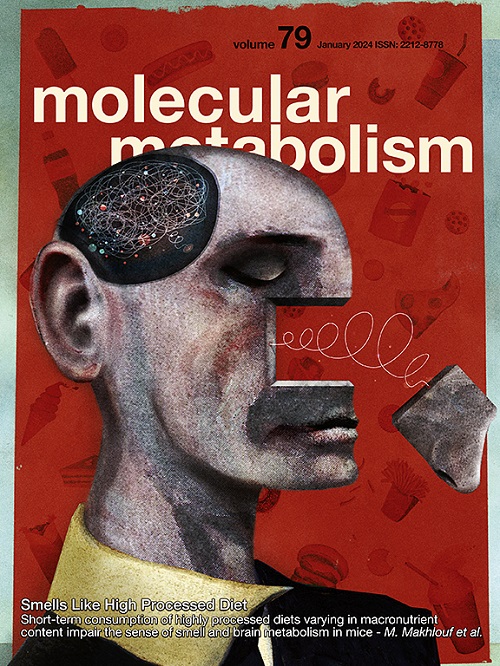Hepatic retinol dehydrogenase 11 dampens stress associated with the maintenance of cellular cholesterol levels
IF 7
2区 医学
Q1 ENDOCRINOLOGY & METABOLISM
引用次数: 0
Abstract
Objective
Dysregulation of hepatic cholesterol metabolism can contribute to elevated circulating cholesterol levels, which is a significant risk factor for cardiovascular disease. Cholesterol homeostasis in mammalian cells is tightly regulated by an integrated network of transcriptional and post-transcriptional signalling pathways. Whilst prior studies have identified many of the central regulators of these pathways, the extended supporting networks remain to be fully elucidated.
Methods
Here, we leveraged an integrated discovery platform, combining multi-omics data from 107 strains of mice to investigate these supporting networks. We identified retinol dehydrogenase 11 (RDH11; also known as SCALD) as a novel protein associated with cholesterol metabolism. Prior studies have suggested that RDH11 may be regulated by alterations in cellular cholesterol status, but its specific roles in this pathway are mostly unknown.
Results
Here, we show that mice fed a Western diet (high fat, high cholesterol) exhibited a significant reduction in hepatic Rdh11 mRNA expression. Conversely, mice treated with a statin (3-hydroxy-3-methyl-glutaryl-coenzyme A reductase (HMGCR) inhibitor) exhibited a 2-fold increase in hepatic Rdh11 mRNA expression. Studies in human and mouse hepatocytes demonstrated that RDH11 expression was regulated by altered cellular cholesterol conditions in a manner consistent with SREBP2 target genes HMGCR and LDLR. Modulation of RDH11 in vitro and in vivo demonstrated modulation of pathways associated with cholesterol metabolism, inflammation and cellular stress. Finally, RDH11 silencing in mouse liver was associated with a reduction in hepatic cardiolipin abundance and a concomitant reduction in the abundance of proteins of the mitochondrial electron transport chain.
Conclusion
Taken together, these findings suggest that RDH11 likely plays a role in protecting cells against the cellular toxicity that can arise as a by-product of endogenous cellular cholesterol synthesis.
肝脏视黄醇脱氢酶 11 可抑制与维持细胞胆固醇水平有关的压力
肝脏胆固醇代谢失调可导致循环胆固醇水平升高,而胆固醇水平升高是心血管疾病的一个重要风险因素。哺乳动物细胞中的胆固醇平衡受到转录和转录后信号通路综合网络的严格调控。虽然先前的研究已经确定了这些通路的许多中心调节因子,但扩展的支持网络仍有待充分阐明。在这里,我们利用综合发现平台,结合来自 107 个品系小鼠的多组学数据来研究这些支持网络。我们发现视黄醇脱氢酶 11(RDH11,又称 SCALD)是一种与胆固醇代谢相关的新型蛋白质。先前的研究表明,RDH11 可能受细胞胆固醇状态变化的调控,但其在这一途径中的具体作用大多尚不清楚。在这里,我们发现以西式饮食(高脂肪、高胆固醇)喂养的小鼠肝脏 Rdh11 mRNA 表达量显著减少。相反,用他汀类药物(3-羟基-3-甲基戊二酰辅酶 A 还原酶(HMGCR)抑制剂)治疗的小鼠肝脏 Rdh11 mRNA 表达量增加了 2 倍。在人和小鼠肝细胞中进行的研究表明,RDH11 的表达受细胞胆固醇条件改变的调节,其方式与 SREBP2 靶基因 HMGCR 和 LDLR 一致。体外和体内对 RDH11 的调节表明,与胆固醇代谢、炎症和细胞应激相关的通路也会受到调节。最后,小鼠肝脏中 RDH11 的沉默与肝脏心磷脂丰度的降低以及线粒体电子传递链蛋白丰度的降低有关。综上所述,这些研究结果表明,RDH11 可能在保护细胞免受内源性细胞胆固醇合成副产品引起的细胞毒性方面发挥了作用。
本文章由计算机程序翻译,如有差异,请以英文原文为准。
求助全文
约1分钟内获得全文
求助全文
来源期刊

Molecular Metabolism
ENDOCRINOLOGY & METABOLISM-
CiteScore
14.50
自引率
2.50%
发文量
219
审稿时长
43 days
期刊介绍:
Molecular Metabolism is a leading journal dedicated to sharing groundbreaking discoveries in the field of energy homeostasis and the underlying factors of metabolic disorders. These disorders include obesity, diabetes, cardiovascular disease, and cancer. Our journal focuses on publishing research driven by hypotheses and conducted to the highest standards, aiming to provide a mechanistic understanding of energy homeostasis-related behavior, physiology, and dysfunction.
We promote interdisciplinary science, covering a broad range of approaches from molecules to humans throughout the lifespan. Our goal is to contribute to transformative research in metabolism, which has the potential to revolutionize the field. By enabling progress in the prognosis, prevention, and ultimately the cure of metabolic disorders and their long-term complications, our journal seeks to better the future of health and well-being.
 求助内容:
求助内容: 应助结果提醒方式:
应助结果提醒方式:


